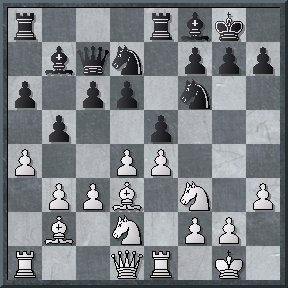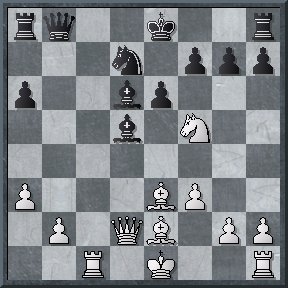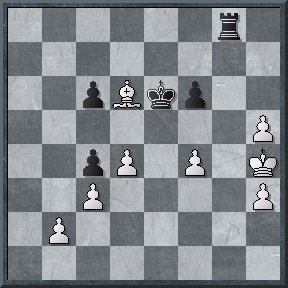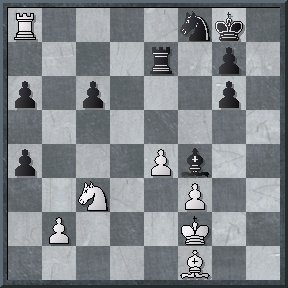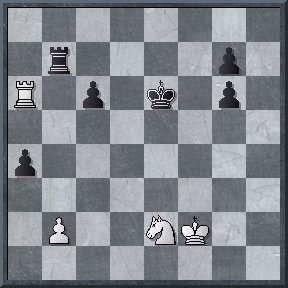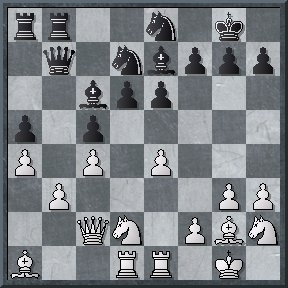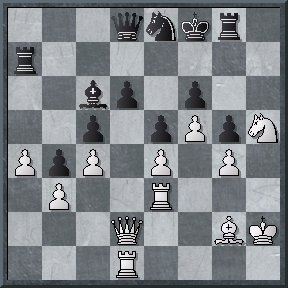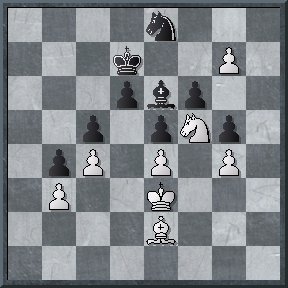11.11.2006
TAL MEMORIAL. GAMES OF ROUND 4 COMMENTED
In round 4 fighting spirit somehow left only one game unattended, thus let`s start with "the ugly duckling"
Svidler,P (2750) - Carlsen,M (2698) [C95]
Tal Memorial Moscow RUS (4), 10.11.2006
1.e4 e5 2.¤f3 ¤c6 3.Ґb5 a6 4.Ґa4 ¤f6 5.0-0 Ґe7 6.¦e1 b5 7.Ґb3 d6 8.c3 0-0 9.h3 ¤b8 10.d4 ¤bd7 11.¤bd2 Ґb7 12.Ґc2 ¦e8 13.a4 Ґf8 14.Ґd3 c6 15.b3 Јc7 16.Ґb2
It is somewhat strange to me but Breyer variation gains some popularity among the top players in spite of its definite passiveness. However, it is perfectly solid. If you forgive me a small lyrical digression... this variation reminds me my youth period. More common here is 16...g6 I practiced the position after 17.Јc2 Ґg7 at least three times in my life. After 18.c4 the game Aseev-Yemelin, Elista 1994 though came unnoticed yet has some theoretical meaning: 18...bxc4 19.Ґxc4 This position is evaluated as clear white`s advantage with reference to Piket in Chess Informant 49 (or 50?) after 18...exd4 20.Ґxd4 ¦e7! 21.b4 ¦ae8 22.Ґd3 c5 23.¦ac1 Јd8= the game is equal. But the pre-history was a loss to Almasi after 18...bxa4?! and now I happened to be the first to have encountered with 19.c5! (Almasi-Yemelin, Bratislava 1993) Why me? The fate chose the most offending way: after managing to equalize this miserable position black blundered. The consequence was being only a vice-champion on tie-break. And the first on tie-break was of course the one who actually read that damned Informant! The Piket`s recommendation, folks! That`s unbelievable!
Magnus Carlsen tries to cut he Gordian`s knot immediately with the novelty: 16...d5 I am used to the fact that this breakthrough in Breyer is a constant threat that actually never equalizes. Yet the complexity of the position requires much of calculation from white. 17.dxe5 The most natural and logical. An alternative is17.exd5 ¤xd5 (17...exd4 18.dxc6) and now 18.Јc2! ( tempting 18.dxe5 ¤f4 19.Ґe4 ¤xe5 (not 19...¤c5 20.Јc2) 20.¤xe5 ¦xe5 21.c4 ¦g5! (21...¦ee8 22.Јc2 with advantage was white`s idea ) suddenly leads to unclear complications; simple 18.¤xe5 simply simplifies (the tautology, yes) the position 18...¤xe5 19.dxe5 ¦xe5 20.Ґe4 ¤f6 21.c4 ¦e6) After 18...exd4 (18...¤5f6 19.dxe5 ¤xe5 20.¤xe5 ¦xe5 21.c4+/=) 19.Ґxh7+ ўh8 20.¤xd4 black will win white bishop with g7-g6 with unclear but perhaps favourable for white consequences. 17...¤xe5 18.¤xe5 Јxe5 19.¤f3 Јf4
20.exd5?! Surely, Peter must have calculated a lot of variations to find grounds for this deviation from fight. Yet at the first sight continuations 20.e5 ¤e4 21.Јc2 or 20.Ґc1 Јc7 21.e5 ¤e4 22.Јc2 (not 22.Ґxe4 dxe4 23.¦xe4 c5 24.¦e1 b4) seems to be not only more combative but also quite promising for white. 20...¤xd5 21.c4 ¤b4 22.Ґe5 Јh6 23.Ґe4 ¦ad8 24.Јb1 bxc4 25.bxc4 Ґa8 26.Ґc3 c5 27.Ґxa8 ¦xa8 28.¤e5 Јe6 29.Јb3 1/2-1/2
The following game of two players who could not find their play in the first rounds was to decide who would be given a chance to recover and who would keep enduring the dark stripe.
Morozevich,A (2747) - Grischuk,A (2710) [B80]
Tal Memorial Moscow RUS (4), 10.11.2006
1.e4 c5 2.¤f3 d6 3.d4 cxd4 4.¤xd4 ¤f6 5.¤c3 a6 6.f3 e6 7.Ґe3 b5 8.Јd2 b4 9.¤a4 ¤bd7 10.c4 bxc3 11.¤xc3 Ґb7 12.Ґe2 d5 13.exd5 ¤xd5 14.¤xd5 Ґxd5 The position took place for the first time in Anand-Topalov, Mtel Masters 2006 that went on with 15.0-0 Јb8 Morozevich uncovers a new idea: 15.¦c1!? Јb8 16.a3 Ґd6 17.¤f5
The critical continuation was of course17...Ґe5 Grischuk must have disliked that black is not threatening to castle immediately after this move, but can white use it? The choice is between a pawn sacrifice 18.f4 g6! 19.fxe5 gxf5 20.0-0 with unclear consequences, or more solid 18.b4 ¤b6 19.g3 (less attractiveis 19.¤g3 0-0 20.f4 Ґf6 21.0-0 (21.¤h5?! Ґh4+) ) 19...0-0 20.¤e7+ ўh8 and now white has a nice resource 21.¦c6! Clearsubmission to white`s will leaves black in a worse position with no counterplay. 17...0-0?! 18.¤xd6 Јxd6 19.0-0+/= a5 20.a4! This strong move emphasizes black`s problem. A small pawn on a5 spoils the whole position. 20...¦fd8 21.Ґb5 h6 22.¦c3 ¤f8 23.¦fc1 ¤g6 24.Јf2 ¦db8 25.¦c7 Јb4 26.Јd2 ¦xb5 27.axb5 Јxb5 28.¦c8+ ¦xc8 29.¦xc8+ ўh7 30.¦c5 Јb7 31.¦xa5 ¤e5 32.Јc2+ ўg8 33.¦c5 ¤c6 34.h3 f5 35.Јc3 1-0
Shirov,A (2720) - Aronian,L (2741) C89
Tal Memorial Moscow RUS (4), 10.11.2006
1.e4 e5 2.¤f3 ¤c6 3.Ґb5 a6 4.Ґa4 ¤f6 5.0-0 Ґe7 6.¦e1 b5 7.Ґb3 0-0 8.c3 d5 9.exd5 ¤xd5 10.¤xe5 ¤xe5 11.¦xe5 c6 12.d4 Ґd6 13.¦e1 Јh4 14.g3 Јh3 15.¦e4 g5 16.Јf1 Јh5 17.¤d2 Ґf5 18.f3 ¤f6 19.a4 ¤xe4 20.¤xe4 Јg6 21.¤xd6 Јxd6 22.Ґxg5 Something familiar...
22...Јg6 We can see something supersubtle to be understood here. Aronian deviates from played by the other Armenian ... oops, sorry, my mistake... but he played in Armenia-Rest of the world match for Armenia, how should I know?!.. by the hungarian GM in the previous round 22...¦fe8 Shirov-Leko, Tal memorial (round 3) 2006 but Shirov can transpose to that game by 23.Ґe7 ¦fe8 24.¦e1 So what is the point? Why did Shirov repeat the variation and why Aronian invents an improvement? The answer certainly hides at this point, but where? I may dare suppose it is something to do with axb5 and Јc1, but I cannot believe there`s something in a position that can question the overall drawish evaluation of Leko`s novelty. Anyway, after 22...¦fe8 23.axb5 (23.Јc1 ¦e2 is obviously undesirable; 23.g4 Јg6 24.Јc1 Ґd3 25.axb5 may be interesting) 23...axb5 24.¦xa8 ¦xa8 25.Јc1 Јg6 white gains a tempo in comparison to the current game. 23.Јc1 May be the beginning of white`s problems. 23...Ґd3 24.axb5 axb5 25.¦xa8 ¦xa8 26.ўf2 Ґc4 27.Ґxc4 bxc4 28.g4 ¦e8 29.Ґf4 Јd3 30.ўg3 Јe2
In the last moves Aronian clearly outplayed his opponent and white is in danger in this position. 31.Јb1?! After this black exchanges queens and white`s passive bishop bound by the necessity to protect b2-pawn dooms white to just some vague drawish prospects. After 31.Ґe5 f6! 32.Ґxf6 ¦e3 33.Јh1 Јxb2 34.Ґg5 ¦e8 (34...Јxc3 35.Ґxe3 Јxe3 36.Јa1=) 35.Јc1 Јxc1 36.Ґxc1 ¦a8!=/+ black manages to force white bishop to a passive position in the endgame, yet white seems to be able to hold with the help of his kingside pawns. 31...Јe1+ 32.Јxe1 ¦xe1 33.Ґd6 ¦g1+ 34.ўf2 ¦b1 35.Ґa3 ўg7 36.ўg3 ўg6 37.h3 h5 38.ўh4 ¦g1 The king is cut, the bishop pinned to b2. Zugzwang motives are obvious. 39.Ґc5 ¦g2 40.Ґa3 f6 41.gxh5+ ўf5 Interesting decision if we bear in mind that simple41...ўg7 made white sacrifice some of the pawns. 42.f4 ¦g8 43.Ґd6 ўe6
44.h6?! Maybe Shirov considered his position to be hopeless anyway? After 44.Ґa3 black would probably have to return his king to the 7th rank similar to the note to move 41 immediately (44...ўf7) or after some "cat-and-mouse" amusements: 44...¦b845.ўg4 (45.h6!? ўf7 46.f5 ¦g8 brings white eventually nothing but pawns casualties) 45...¦g8+ 46.ўh4 ўf7 It`s hard to believe that Shirov failed to see the idea that is a commonplace for so many studies, but who knows. 44...ўxd6 45.ўh5 f5 46.h7 ¦h8 47.ўg6 ўe7 48.ўg7 ўe8
The position demands a diagram and a meaningful silence. 49.ўg6 ўf8 50.h4 ўe7 51.ўg7 ўe8 52.ўg6 ўf8 53.h5 ўe7 54.ўg7 ўe8 55.ўg6 ўf8 56.h6 ўe8 57.ўf6 ¦xh7 58.ўg6 ¦f7! This way black manages to make white put another pawn to h7, and then black repeats the trick:58...¦f7 59.h7 ¦f8 60.ўg7 ¦h8 The same could be done less precise by 58...¦h8 59.ўg7 ¦f8 60.ўg6 ўe7 61.ўg7 ¦b8 62.h7 (62.ўg6 ¦g8+) 62...¦h8! 0-1
For some reason Gelfand chose a rather passive variation against Leko. Let`s start observing the endgame from the following point:
Leko,P (2741) - Gelfand,B (2733) [D19]
Tal Memorial Moscow ¦US (4), 10.11.2006
With two bishops white enjoys a stable advantage. After his last move (g4-g5) black could remove the knight from f6 to d7 or h5: 29...¤d7 30.¤e2, 29...¤6h5 30.b4 with the idea Ґc5, white`s advantage didn`t become less, but after ¤f6-h7 white had 30.e5! and after 30...Ґxe5 (30...¤e6 31.f4) 31.¦d8+ ¤f8 32.Ґc5 ¤4g6 33.Ґxe7 (33.Ґh3 ¦c7) 33...¤xe7 34.Ґd3 Ґf4 (34...g6 35.¦e8) 35.¤e4+- white has all the grounds to hope to convert an extra exchange to a victory. Did Leko see this idea? Or may he consider the position after 30...¤e6 not clear enough? Difficult to say. Leko unleashes his fantasie with tricky and impressive alternative 30.Ґxf4!? Ґxf4 31.¦d8+ ¤f8 32.g6! b5 logical 32...¦d7 actually brought no much relief: 33.¦a8 ¦d2+ 34.ўe1 ¦d4 35.¤e2 Ґd2+ 36.ўd1 33.Ґh3 fxg6 34.¦a8 bxa4 after 34...ўf7 white has a choice between 35.¦xa6 bxa4 36.¤xa4+/- with clear advantage or tempting 35.a5 35.Ґf1!
An ultimate embodiment of white`s concept. White wins a piece. 35...ўf7 After35...Ґe5 white can event fall into a trap 36.Ґc4+ (36.¤xa4 is quite enough) 36...ўh7 37.¦xf8 a3 (the point) 38.¤b1 and black pawns will be blockaded. 36.Ґc4+ ¤e6 37.¤e2! Ґd6 38.f4 ўf6 39.e5+ Ґxe5 40.fxe5+ ўxe5 41.Ґxe6 ўxe6 42.¦xa6 ¦b7
43.¤f4+! A very instructive moment. By finding a perfect square for his knight Leko significantly reduces the technical difficulties. 43.¦xc6+ ўe5 44.¦c2 ¦a7 would be less precise. 43...ўe5 44.ўe3 c5 45.¤d3+ ўd5 46.¦a5 ўd6 47.¦xa4 ўd5 48.¦a5 ўd6 49.¦a4 ўd5 50.ўd2 c4 51.¤b4+ ўe4 52.ўc3 g5 53.¤c6 g4 54.¦xc4+ ўf5 55.¤d4+ ўf4 56.¤c6+ ўf5 57.¤b4 g3 58.¤d5 ўe5 59.¤e3 ¦f7 60.¦g4 ¦c7+ 61.¤c4+ ўf5 62.¦xg3 g5 63.¦f3+ ўe4 64.¦f7 ¦c8 65.¦g7 ўf4 66.ўd3 ¦d8+ 67.ўe2 ¦e8+ 68.ўf2 ¦b8 69.¦f7+ ўe4 70.¦d7 g4 71.b3 ¦b4 72.¤d2+ ўf4 73.¦d3 ўf5 74.ўg3 ўe5 75.¤c4+ ўe4 76.¦e3+ ўd4 77.ўxg4 ¦b8 78.ўf3 ¦h8 79.ўe2 1-0
The fact of ending up with draw doesn`t prevent the game between non-compromising fighters from being a true canvas.
Mamedyarov,S (2728) - Ponomariov,R (2703) [E16]
Tal Memorial Moscow ¦US (4), 10.11.2006
1.d4 ¤f6 2.c4 e6 3.¤f3 b6 4.g3 Ґb4+ 5.¤bd2 Ґb7 6.Ґg2 0-0 7.0-0 Ґe7 8.b3 c5 9.dxc5 bxc5 10.Ґb2 d6 11.Јc2 ¤bd7 12.¦ad1 Јc7 13.e4 Ґc6 14.¦fe1 Јb7 15.h3 a5 16.a4 ¦fb8 17.¤h2 ¤e8 18.Ґa1
18...Ґf6 This positionally desirable exchange leaves black in a passive though perfectly solid position, an alternative could be 18...e5!? trying to blackmail white with ¤f8-e6-d4 manouevre. After19.f4 exf4 20.gxf4 Ґh4 21.¦f1 Ґf6 black has counterplay. 19.Ґxf6 ¤dxf6 20.f4 ¦a6 21.¤hf3 Јe7 22.ўh2 e5 23.f5 No use of holding the tension:23.Јc3 ¤d7 23...¦ab6 24.¦e3 h6 25.g4 ¤c7 26.¦g1 g5 27.Ґf1 ўg7 28.h4 ¦h8 29.hxg5 hxg5+ 30.Ґh3 ¤fe8 31.¤f1 f6 32.Јd2 ¦a6 33.¤g3 ўf8 34.¤h5
The picture tells us everything about the course of the fight. White gained space reached definite pressure and prepared a trap... yet his useless bishop doesn`t allow him to break black`s defensive wall. 34...¦g8 Black defends vigilantly. Natural 34...¤g7? would be fatal: 35.¤xg5! ¤xh5 36.gxh5 fxg5 37.f6 Јd8 38.¦f3! ¦xh5 39.¦xg5+- 35.¦d1 ¦a7 36.¤e1 ¤a6 37.¤c2 Јd8 38.Ґg2 ¤b4 39.¤xb4 White is of course reluctant to pay such a high price for putting the knight to b5 as allowing black knight to d4: 39.¤a3 ¦d7 40.¤b5 Ґb7 39...axb4
Black has a fortress.40.¦d3 ¦d7 41.ўg3 ¦h8 42.Ґf3 ¦hh7 43.¦h1 ўg8 44.¦d1 ўf8 45.ўf2 ўg8 46.Ґg2 ўf8 47.¦h1 ўg8 48.¦dh3 ¦df7 49.¦1h2 Јe7 50.Ґf3 Јd8 51.Јc1 Јe7 52.Јh1 Ґb7 53.a5 Ґa6 54.Јd1 Ґb7 55.Јa1 Ґa6 56.Јh1 Ґb7 57.¤g3 ¦xh3 58.¦xh3 ¦h7 59.¦xh7 Јxh7 60.Јa1 Ґa6 61.Јa4 ўf8 62.¤f1 Јb7 63.¤e3 ўe7 64.Јa1 ўd8 65.Јh1 Јg7 66.¤d5 ўd7 67.Јh5 ўd8 68.Ґe2 ўd7 69.Јg6 Јxg6 70.fxg6 Ґc8 71.ўg3 ўc6 72.¤e7+ ўc7 73.¤f5 Ґe6 74.g7 ўb7 75.ўf2 ўa6 76.ўg3 ўxa5 77.ўf2 ўb6 78.ўg3 ўc7 79.ўf2 ўd7 80.ўe3
1/2-1/2

